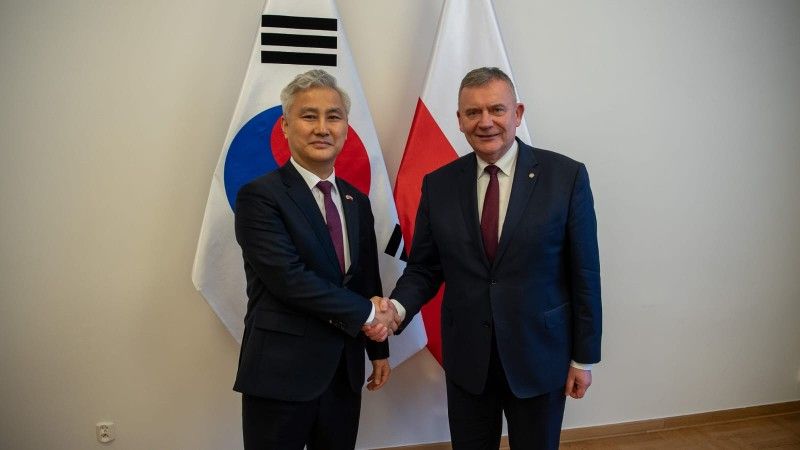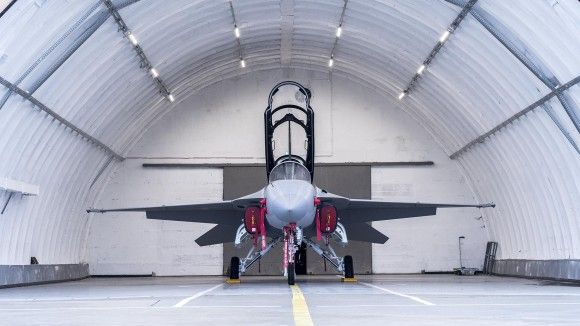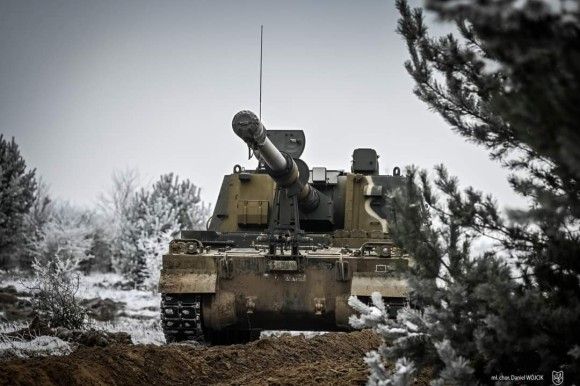Defence Policy
DAPA Minister: We will Give the Best to Support the Transfer of Technology to Poland. What about Financing? [INTERVIEW]

Photo. MON
I would like to say that the Korean government and the concerned institutions are vigorously launching multiple efforts, including amending the Export-Import Bank of Korea Act to increase its equity capital, in a bid to expand financial support measures - as Eom Dong-Hwan, DAPA Minister, said in an interview with Defence24.pl.
Jędrzej Graf: It has been about a year and a half since Poland signed the framework contract for defence procurement with the Republic of Korea. The first execution contracts were also signed, and deliveries of equipment such as K2 MBT, K239 Chunmoo launchers, K9 howitzers and FA-50 aircraft are ongoing. Mr Minister, how do you assess the cooperation of Korea and Poland, and what are the next steps?
DAPA Minister Eom Donghwan: The Korean government and its domestic defense industries underscore the importance of defense cooperation with Poland. I understand that Poland has been robustly pushing ahead with »defense modernization« in an aim to respond to the ongoing security challenges that Poland is currently facing. After signing the first executive contract, the Korean government and the defense industries have committed to put their priority on a rapid supply of quality weapon systems to Poland. Then comes the second executive contract, where a local production will take place on Polish soil through technology transfer. In cooperation with Korea, Poland is expected to boost its capability to achieve a self-reliant national defense and bolster its defense industries. By doing so, I am confident that Poland will become a country to play a central role in a regional security order.
The unprecedented large-scale arms deals, which are extremely rare on a global scale, allow significant quantities of weapon systems to be transferred from Korea to Poland at a rapid pace. I am confident that Korea plays a part in strengthening Poland’s security posture and safeguarding world peace amidst the political volatility in Europe. In addition, the defense collaboration between the two nations has triggered the expansion of exchanges at the level of B2B and G2G, as well as between militaries. Companies plan to share technologies such as production know-how, while militaries and Ministries intend to hold an increased number of military training to further exchange operation expertise and military doctrines.
Currently, weapon systems are mostly produced in Korea for an export to Poland, but the next stage will focus on incorporating Polish equipment with Korean platform, as witnessed in Homar-K that features a combination of a Korean launcher with Jelcz’s chassis, or manufacture of weapon systems in Poland under license. This partnership is believed to be further advanced in a form of joint export to third markets, or joint R&D in core technologies or weapon systems.
While the first execution contracts were signed and arebeing implemented, the second execution contracts that includes the manufacturing of Korean systems - K2, K9, K239 - in Poland on license have not been signed yet. What are the reasons for it? And how does DAPA support the finalization of the 2nd execution contract?
I am aware that the Polish MoD is in the process of reviewing previous arms contracts, which I fully respect. When review results are released, DAPA plans to commit to the contracts signing and execution, as it has actively done so far.
Since the first execution contract has been concluded in 2022, the Korean government and the defense industries have endeavored to quickly deliver quality weapon systems, including K2, K9, FA-50, and K239. In particular, the first delivery of K2 tanks and K9 self-propelled howitzers were made within just three months after the contract, which was nowhere to be found globally in the history of defense acquisition. When it comes to the second execution contracts, local production and technology transfer are of the utmost importance. DAPA, as an agency in charge of weapon technology, will give its best support to ensure timely and seamless transfer of technology to Poland.
There are media information on financing limits by Korean banks being one of the reasons why it is difficult to conclude the 2nd stage execution contracts. How would you comment on that?
I believe that any matters related to finance is up for the Polish financial authority to decide. Meanwhile, I would like to say that the Korean government and the concerned institutions are vigorously launching multiple efforts, including amending the Export-Import Bank of Korea Act to increase its equity capital, in a bid to expand financial support measures.
In particular, what is the current status of the financial support of Polish purchases of Korean equipment by Korean government and banks? How the financing will influence all the projects, and do you view it is necessary for the projects to take place?
The Korean government is reviwing various ways of financial support for the bilateral defense cooperation with Poland. My answer is limited to provide further details.

Photo. U.S. Army National Guard
Let me move to specific projects. Poland is preparing to sign a second execution agreement for K2 MBT, including the K2PL variant with technology transfer. To what extent is the Polish K2 project coordinated with DAPA by the procurement and modernization effort regarding K2 Main Battle Tank that are being taken in the Republic of Korea?
I understand that discussions are underway by a Korean-Polish consortium comprising Hyundai Rotem, PGZ and WZM to specify the technical specifications of K2PL.
It is expected that the necessary specifications will be added for the Main Battle Tank, given the security climate in Poland, while support vehicles will be developed under the leadership of WZM to apply specifications conducive to the local conditions. In its part, DAPA is also making every effort to move the K2PL project forward, which is expected to be manufactured in Poland.
Poland has also procured K9 howitzers and K239 Chunmoo rocket launchers, both of them are considered critical to the Korean Army Artillery. What is the way Korea wants to develop both those systems? And could Poland take part in development of those systems?
K9 howitzers and K239 Chunmoo rocket launchers are the weapon systems that are critical for the Korean Army to counter North Korea’s long-range artillery. The K9 howitzer was developed in 1999, and its performance including firepower and maneuverability has a proven record of excellence, leading to exports to eight overseas countries. The future K9 howitzer continues its development for MUM-T operations, which include automated turrets requiring less crew members on board.
The K239 Chunmoo multiple rocket launcher, developed in 2013 in support of the Korean Army’s counterfire and deep operations, has been in service with the armed forces since 2015. With rapid maneuverability, precision strike capabilities and high power, the K239 will provide a very effective and powerful deterrent in Poland’s rapidly evolving border situation and security environment. It is already being exported to three countries around the world, including Poland, and is currently working on a joint development with a Polish company to enable operations with various calibers on a same launcher.
As Poland is the world’s biggest purchaser of K9 howitzers and K239 systems, I am confident that defense industrial cooperation based on local production and technology transfer will further accelerate down the road. The Polish-type Cheonmoo, namely Homar-K, is a platform being equpped with a launch pad manufactured by Hanhwa Aerospace on a chassis produced by Jelcz, and the system is assembled locally through HSW, while linking with the C2 system of WBE. This is a prime example of the Korea-Poland defense cooperation where Polish companies take the lead in localization.

Photo. Maciej Szopa/Defence24
Recently, the munitions production is an issue in Europe. How can Republic of Korea to support Poland regarding production of munitions for the K2 Main Battle Tank and K9 howitzers, but also K239 rocket launcher with guided rockets and missiles?
As the demand for large caliber increases across the Europe, it is understood that Poland wishes to engage in technical cooperation with Korea on large caliber ammunition to enter the NATO market. Korean defense firms such as Poongsan and Hanwha Aerospace also recognize the importance of entering the NATO market with Poland. To enhance Poland’s ammunition production capability, Korea will strive to support rapid procedures, including technology transfer, based on continued G2G dialogue to create a new defense collaborative model.
Poland has received the first batch of FA-50 fighter aircraft, and upgraded FA-50PL are to be delivered from 2025. How do you assess the FA-50PL project and what is the Korean approach to develop FA-50 system in general, including by integration of new precision guided weapons?
Korea has supported the timely delivery of FA-50 fighters to Poland in cooperation with related institutions. FA-50, a light attack aircraft, is one of the major fighter jets in operation in Korea. KAI is committed to develop and deliver the remaining 36 units of FA-50PL aircraft in a timely manner. In close cooperation with the Ministry of National Defense and the Air Force, the Korean government is providing aerial tanker support and necessary equipment, as part of efforts to develop air refueling capabilities. As per the integration of new precision guided weapons, I am unable to provide detailed information, but what I can say is that DAPA is scheduled to provide full support in rapid delivery of systems more advanced than those FA-50 already delivered to Poland.

Photo. Mirosław Mróz Defence24.pl
And among those products - K2, K9, K239 and FA-50 - what is in your opinion the most favorable, most benefitial weapon system for Poland?
All the platforms of K2, K9, K239 and FA-50 that Poland purchased from Korea have each of their own advantages in each battlefield, and possess the highest level of performance compared to rivaled models around the world. Therefore, it is difficult to pick just one out of those four. I believe it is in this reason that Poland has decided to purchase all four systems in large quantities in the face of security challenges in Europe.
What are the further areas that Poland and Korea could develop defence cooperation? Is Korea open to cooperation with Poland, for instance, on KF-21 or ground unmanned vehicles? And does Korea consider procurements Polish-developed weapon systems?
In addition to the current K2, K9, K239, and FA-50, the defense industrial cooperation between Korea and Poland can be expanded into various fields. For example, Poland’s defense industrial capabilities will largely benefit from local production with technology transfer during the second execution contract. Moreover, local production of various ammunitions to be fired from the aforementioned weapon systems will be another option to cooperate. Going forward, if guided missiles for K239 are produced locally, joint export to third countries is something both countries can work on together. Business-level discussions on MRO for FA-50 are also underway. Lastly, Polish defense companies may be invited to participate in projects for KF-21, if Poland considers adopting KF-21.
I believe that there is enough potential for cooperation in the field of unmanned ground vehicle, if the two countries agree upon specialized areas of cooperation with the relevant defense industries.

Photo. mł. chor. Daniel Wójcik
What are the prospects for Korean systems exports in Europe in general? And what role can the cooperation with Polish Industry play here?
Korea’s defense export to Europe has been mainly centered on K9 until the defense cooperation with Poland, to which Korea has supplied K2, K9, K239 and FA-50. The two countries are now at the stage to explore joint export. If local production capacity in Poland expands through the second execution contracts, the joint export to third countries is expected to be feasible through local production based in Poland. If the concerned weapon systems are acquired by other countries in Europe, Poland can become a hub of consolidated logistics, covering services of MRO to repair parts supply.
I would also like to have a more general question. It has been two years since the full scale Russian aggression against Ukraine, and we see evolving battlefield environment and instability both in Europe and Asia. What are, in your opinion, the most important areas for defence capability development for countries like Poland and Korea? And how can the cooperation between Poland and Korea support the security of both countres?
I am aware that Poland is pushing ahead with modernization efforts in order to respond to the ongoing security challenges around Poland. Korea stands with Polish efforts to strengthen its national defense. The two countries share the universal values of democracy and market economy, all of which align with the presidential agenda proclaimed by the Korean administration as in „global pivotal state” contributing to freedom, peace and prosperity.
Above all, Korea and Poland are constantly exposed to clear threats from neighboring countries, which necessitate to build reliable self-defense capabilities at all times. Korea is focusing on upgrading its armed forces to overcome a decline in troop size resulted by a shrinking population. To my understanding, Poland is also keen on building military forces by leveraging cutting-edge technologies such as unmanned system. As mentioned earlier, Poland plans to build its own production and MRO capabilities starting from the second execution contracts.
Since the two countries are geographically remote, mutual logistics support will be beneficial for both in the event of a regional conflict. I hope that Poland reminds Korea of a solid partner all the way from East Asia, while a country supporting Poland in boosting its defense posture. I believe the capacity of Polish defense industries will further grow through joint export with Korea, while Poland becoming a key country in setting a security order in Europe. Korea will continue its full support in promoting Poland’s strong self-reliant defense posture and advancing the country’s defense industries.
Thank you for the message.
